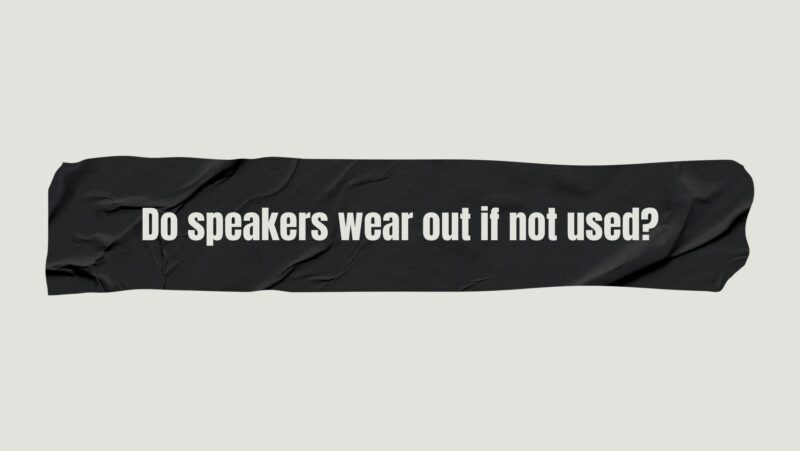The world of technology is often shrouded in myths and misconceptions, and the realm of audio equipment is no exception. One enduring belief that has persisted over time is the notion that speakers can wear out simply through disuse. The idea that these auditory marvels might deteriorate when left silent for extended periods has raised questions about the intricacies of their internal mechanisms and the effects of time on inactivity. In this article, we delve into the heart of this myth, examining the scientific underpinnings and shedding light on whether speakers can truly wear out if not used.
The Mechanics of Sound
Before we explore the concept of speakers wearing out from disuse, it’s important to understand the foundational principles of sound production. Speakers, also known as loudspeakers, are intricate devices engineered to convert electrical signals into audible sound waves. This transformation is achieved through the harmonious interaction of components such as diaphragms, voice coils, magnets, and cones. As an electrical signal courses through the voice coil within a magnetic field, the resulting movement of the diaphragm generates sound waves that grace our ears.
The Myth of Disuse-Induced Wear
The notion that speakers can wear out from disuse is a persistent belief rooted in the idea that mechanical components, left motionless, might degrade over time. However, this myth is not as straightforward as it might appear.
Material Degradation and Inactivity
One of the primary concerns related to disuse-induced wear is material degradation. It’s believed that when speakers remain inactive for prolonged periods, materials within their components might deteriorate due to factors such as humidity, temperature fluctuations, and exposure to environmental elements.
While it’s true that materials can degrade over time, the rate of degradation is influenced by a multitude of factors. Inactivity alone is not a guaranteed catalyst for material breakdown. Modern speakers are constructed with materials designed to withstand a reasonable degree of environmental stress, even when not in use. For example, speaker diaphragms are often made from materials chosen for their durability and resistance to environmental factors.
Mechanical Stress and Inactivity
Another aspect of the myth revolves around the idea that mechanical stress incurred during sound production is essential for maintaining the health of speaker components. The belief is that inactivity leads to stagnation and eventually degradation of these components.
While it’s true that components like diaphragms and voice coils undergo mechanical stress during sound production, this stress is not inherently destructive. Moreover, the degree of stress experienced during regular use is typically within the design parameters of the speaker. Inactivity itself doesn’t result in components becoming brittle or incapable of future movement.
The Role of Lubrication and Suspension
Components like suspension systems and joints within speakers do rely on proper lubrication to ensure smooth movement and accurate sound reproduction. However, the degradation of lubricants over time is a gradual process influenced by factors such as temperature and exposure to air, not merely the absence of activity. Regular maintenance and proper storage can help mitigate the effects of lubricant breakdown even during periods of disuse.
Advancements in Materials and Engineering
Modern speakers are designed with longevity in mind. Advances in materials science and engineering have led to the development of robust and resilient speaker components that can withstand periods of inactivity without suffering significant wear or damage. These components are often tested rigorously for durability under various conditions, ensuring that they remain functional and reliable even after extended periods of non-use.
Caring for Dormant Speakers
While the myth of speakers wearing out from disuse may not be entirely accurate, some best practices can help preserve the quality and longevity of speakers during periods of inactivity:
- Proper Storage: Storing speakers in a controlled environment, away from extreme temperatures, humidity, and direct sunlight, can prevent unnecessary stress on components.
- Regular Inspection: Periodically inspecting speakers for signs of physical damage or deterioration, such as cracked diaphragms or loose connections, can help catch potential issues early.
- Occasional Use: If possible, occasionally using speakers even during periods of disuse can help prevent suspension components from becoming too stiff due to lack of movement.
Conclusion
The myth that speakers can wear out from disuse is an intriguing one, rooted in a blend of scientific speculation and anecdotal observations. While inactivity alone is not a direct cause of speaker degradation, it’s essential to acknowledge that speakers, like all mechanical devices, are subject to the laws of time and the environment. Advances in materials, engineering, and manufacturing have rendered modern speakers resilient, designed to withstand reasonable periods of inactivity without significant wear. While best practices such as proper storage and occasional use can contribute to preserving speaker quality, the idea of speakers deteriorating merely from sitting silent is more fiction than fact. The world of audio equipment is vast and fascinating, and while speakers might rest, the symphony of sound continues to play on.


